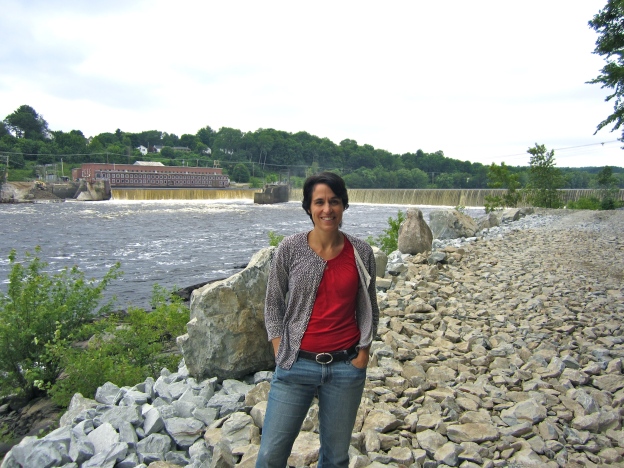
Today you’re hearing from Kate Dempsey, the External Affairs Director for The Nature Conservancy in Maine. Photo courtesy of Kate.
At first glance, the dams along Penobscot River don’t look particularly imposing. But to an Atlantic salmon, each dam is as daunting as the Great Wall of China, blocking the route to hundreds of miles of their historic spawning habitat. Salmon that manage to climb the fish ladders emerge exhausted. For fish like shad, rainbow smelt and striped bass, the upstream side of the dam might as well be the far side of the moon. But that is all changing, thanks to the promise made through the Penobscot River Restoration Project.
Today, when I stand along the Penobscot River where the Great Works Dam used to hold back this mighty river, I have to catch my breath.

The former Great Works Dam site. Photo courtesy of the Penobscot River Restoration Trust.
It’s still hard to believe that 1000-foot wide concrete dam is now gone and people are kayaking the rapids and fish are swimming through the rips. I shout over the roar of flowing water.
This summer, as the Veazie Dam starts coming down, I’m watching eagerly as the construction vehicles maneuver through the water securing the promise of a free-flowing entire lower section of the Penobscot River. By next year the river will flow freely from the first natural falls clear to Penobscot Bay for the first time in more than 180 years.

A photo of Veazie Dam by the Penobscot River Restoration Trust.
For me, the Penobscot Project has become more than just part of my day job, it embodies what I believe we need to be considering in all of our lives: How do communities, businesses, governments and organizations work to create solutions that meet a variety of needs. And how can nature help solve those problems?
Carefully removing dams from the Penobscot solves a host of problems. Scientists believe the Penobscot represents the last best hope for recovery of Atlantic salmon in the United States. When the project is complete, access to nearly 1,000 miles of habitat will be greatly improved for 11 species of native sea-run fish, including Atlantic salmon, American shad, two river herring and American eel.
Lower river species such as endangered shortnose sturgeon, threatened Atlantic sturgeon, striped bass, and rainbow smelt will have 100 percent of their historic spawning and juvenile growing habitat restored. Increases in river herring will likely expand the food supply for many commercially important species in the Gulf of Maine that prey on these smaller fish, including cod and haddock.
From the expansive forests and streams of across Maine to the Penobscot estuary to the Gulf of Maine, restored fish populations will have cascading benefits for whole communities of plants, animals and people. And the Penobscot Settlement Agreement ensures the river will continue to provide low-carbon electricity to local communities.
| Wait – there’s more! We’re sharing videos and posts all season from our staff and partners working on the Penobscot River. |
Because of our willingness to work persistently together, to find places of common ground and places to compromise, we are taking out the Veazie Dam this summer and we will finish the Penobscot Project together in the coming years. And that is delivering on a promise.

Pingback: Fingers Crossed for East Coast Salmon | State Wildlife Research News
Pingback: Knock down that dam! | U.S. Fish and Wildlife Service Northeast Region